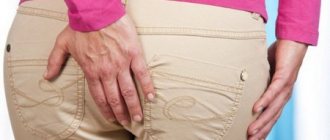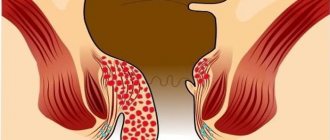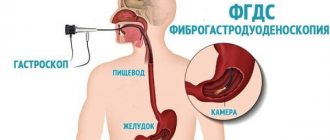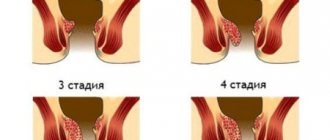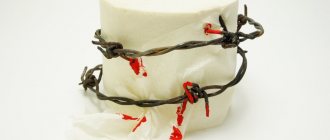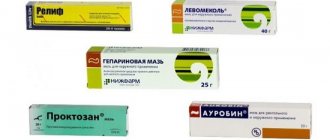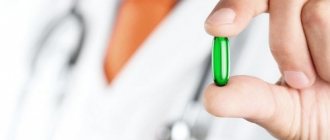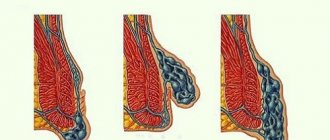What does it look like?
Manifestations of hemorrhoids can be noticed at the very beginning of the disease. But many people ignore the symptoms of stage 1 hemorrhoids until the last moment.
If hemorrhoids are not recognized at an early stage and appropriate treatment measures are not taken, they will develop into a more advanced form, which will be more difficult and longer to get rid of.
Stage 1 cannot be determined visually
Hemorrhoids of the first stage are often detected by chance during other examinations and medical examinations. A more detailed interview with the patient reveals that he experienced unpleasant symptoms, but did not consider them serious enough to see a doctor.
Signs of early stage hemorrhoids:
- Heaviness and sensation of a foreign body in the rectum.
- Soreness, itching, burning in the anus.
- Pain during bowel movements.
- The appearance of blood after defecation.
- Discharge of mucus between bowel movements, mucus in the stool.
The initial stage of hemorrhoids looks like small problems with stool, which occur in almost everyone from time to time. The pain is not very pronounced or is absent at all.
Hemorrhoids can be internal or external:
- In the first case, only a doctor can examine small bumps in the rectum during an examination.
- In the second, they are noticeable to the patient himself, and look like small lumps or bumps near the anus.
The longer the disease develops, the darker the color of hemorrhoidal cones. Even if the hemorrhoids are located internally, the outer part of the anus is inflamed.
In men
Hemorrhoids in men most often appear between the ages of 30 and 50 , especially in those who lead a sedentary lifestyle. May occur in those who frequently lift heavy objects at work.
Many men refuse to use rectal suppositories, and often quit treatment immediately after the unpleasant symptoms decrease. Therefore, the doctor’s task is to select the most comfortable form of the drug and convince the patient to complete the entire course.
Everything about the features of treating male hemorrhoids is written in this article: what causes hemorrhoids in men?
Among women
In women, the disease often appears as a result of stress, after rapid weight loss, or during sedentary work.
Only a specialist can tell you what to do in the initial stages of hemorrhoids, depending on the cause of the problem.
A diet and pills may be recommended that will simultaneously help cope with varicose veins.
Stage 1 hemorrhoids in women often occur during pregnancy. In the early stages of pregnancy, hemorrhoids appear as a result of constipation and increased pressure on the rectal area.
Tablets are prescribed to pregnant women extremely rarely , due to the high risk for the child.
But the disease cannot be completely ignored: after childbirth, hemorrhoids may worsen. Therefore, pregnant women are prescribed suppositories and ointments, gentle traditional methods of treatment.
Type of initial stage of hemorrhoids
Many patients do not know how to recognize hemorrhoids. But visually it also has a number of signs.
What does hemorrhoids look like? Hemorrhoids can be internal or external.
The external type of disease at the initial stage has nodes of a smooth and even structure. They are located directly in the anal area. They are no different in color from the skin. When pressed, they do not cause strong painful or unpleasant sensations.
But each time, as blood accumulates, the nodes increase in size and become painful. In the second stage of hemorrhoids, they change color and become purple.
Determining the presence of an internal disease is much more difficult. It is simply impossible to do this on your own. But when diagnosing, the attending physician examines the digestive area using a special device. This procedure has received several names: colonoscopy, sigmoidoscopy and anoscopy.
In the early phase of the disease, inflammatory elements are observed on the skin around the anus. At the same time, he is swollen and hyperemic.
Small changes can be seen inside the mucous membrane of the intestinal canal. They resemble spots with a bluish tint. This process signals an enlarged vein. Gradually, the spot degenerates into a hemorrhoidal bump.
Diagnostics
Symptoms of early stage hemorrhoids are not the only reason to give a person such a diagnosis.
For examination, the doctor uses:
- An examination during which a lump or slight swelling of the vein may be detected. During the examination, manual palpation is performed. A rectal mirror is also used, which allows you to see nodes at a depth of up to 15 cm.
- Fecal occult blood test.
More detailed diagnostic methods: anoscopy, sigmoidoscopy, sphincterometry, etc.
The first stage of hemorrhoids is not dangerous and timely treatment will help you get rid of this disease forever.
Treatment of grade 1 hemorrhoids without surgery
At the first or initial stage, treatment of external and internal hemorrhoids consists of relieving discomfort in the anorectal area, normalizing the microcirculation of the rectum in order to stop the progression of the pathology.
Sometimes just changing your lifestyle and balancing your diet is enough to cope with the problem. This approach is effective and preferable at the very beginning of the formation of hemorrhoidal cones.
If the measures taken are insufficient, treatment of grade 1 hemorrhoids is carried out with complex, exclusively conservative therapy. It seems that it is easier to use external medications; they have a targeted effect on the lesion. But the tablets have their advantages: no irritation to the intestinal mucosa and a positive effect on the entire body. Therefore, experts prescribe a combination of them.
Rarely, a coloproctologist may suggest surgery using minimally invasive techniques (large single lumps, bleeding, combined forms). At this stage, treatment with folk remedies at home also gives good results.
Correction of lifestyle and nutrition
This method of therapy is used when a patient is diagnosed with grade 1 chronic hemorrhoids. If the process is acute, all manifestations of inflammation of the tissues of the anorectal zone are first stopped.
First of all, it is necessary to increase the patient’s physical activity: dancing, aerobics, gym without strength loads, sports exercises for the abs or “plank”, cycling, skiing, swimming. With a sedentary lifestyle, it is recommended to do exercises and warm-ups every couple of hours. The essence of the movement is to strengthen the pelvic floor muscles.
You need to pay attention to the shoes you wear. Sometimes a 15 cm heel can simply be a death sentence: such is the load on the pelvic organs due to the unnatural position of the spine. Shoes should be comfortable, your feet should not get tired in them.
It is better to replace driving by walking.
You should forget about bad habits. For young people this is not difficult, but the older generation needs to show willpower: smoking and alcohol stimulate congestion in the veins of the anus and rectum, that is, they become the root cause for the formation of hemorrhoids. The statement is true for all stages of the disease.
Rectal hygiene should become a habit. Experts insist on giving up toilet paper: after each bowel movement, wash with cool water without soap, which dries the skin and mucous membranes, and provokes anorectal fissures.
Treatment of stage 1 hemorrhoids necessarily includes following a diet. Meals should be five to six times a day, in palm-sized portions. Food is steamed, baked, stewed or boiled.
Anything that irritates the intestinal mucosa or rectum is excluded from the daily diet: salty, spicy, fatty, fried. Foods that provoke flatulence are prohibited: fatty meat, fish, poultry, black bread, pastries, grapes, cabbage, sweets.
It is recommended to consume lean meats, fish, poultry, dairy products, fresh vegetables, fruits, and cereals.
Be sure to drink enough clean water every day, at the rate of 40 ml per 1 kg of weight. This will prevent compaction of stool and the formation of fecal stones.
Drug therapy
If diet and an active lifestyle are not enough to stop the progression of the pathological process, specialists use comprehensive drug treatment for hemorrhoids. A regimen for taking medications at home is developed for each patient individually, taking into account physiological characteristics, indications and contraindications, which are correlated with the symptoms of the disease.
The general scheme of treatment for hemorrhoids with external and internal localization of hemorrhoidal cones is presented in the tables.
Venotonic drugs
Venotonics are the basis of drug treatment for hemorrhoidal disease; they increase the tone of varicose caverns, normalize the outflow of blood from the anorectal area, and are indicated for internal and external hemorrhoids of the first degree.
| Drug name | Cost in rubles |
| Detralex | Tablets – from 640 |
| Venarus | Tablets – from 490 |
| Troxevasin | Tablets – from 300 Ointment – from 322 |
| Phlebodia 600 | Tablets – from 850 |
| Antistax | Tablets – from 580 |
| RectActive | Candles – from 250 |
| Ginkor Procto | Candles – from 250 |
| Proctis M | Candles – from 450 |
| Witch hazel DN | Candles – from 100 |
| Procto-Glyvenol | Candles – from 334 Ointment – from 360 |
| Indovazin | Ointment – from 243 |
| Essaven-gel | Ointment – from 1600 |
How to treat?
For the complex treatment of hemorrhoids in the initial stages of development, tablets, ointments and suppositories are used. The form of the drug is chosen by the proctologist , depending on the patient’s condition, existing contraindications, age and other factors.
Traditional methods
In the initial stages of hemorrhoids, suppositories are used to alleviate the condition. They soften, relieve inflammation, relieve itching, and at the same time facilitate subsequent bowel movements, making them less traumatic for the rectum.
- Sea buckthorn suppositories heal quickly.
- Suppositories with methyluracil will help relieve inflammation and infection.
- Relief Ultra, Prostopin and others are also used.
Ointments have a resolving effect and relieve inflammation.
- Levomekol and Heparin ointment are most often found in proctologist prescriptions.
- To reduce pain during the treatment of stage 1-2 hemorrhoids, Lidocaine and Anestezin are prescribed.
Tablets are a medicine with a long duration of action and do not give an immediate effect. But in the long term it will reduce the risk of exacerbation.
The same medications that are prescribed for varicose veins will help cure hemorrhoids:
- Detralex,
- Posterisan,
- Proctosedyl.
These remedies have a general strengthening effect on blood vessels and keep them in good shape.
Treatment with folk remedies
Baths with infusion of birch leaves are effective . You can take them every other day, each lasting no more than 15 minutes.
- To prepare the infusion, you need to take 5 liters of boiling water, pour 9-10 handfuls of birch leaves over it, and leave for at least 15 minutes under the lid.
- The infusion should be cooled before use, as a hot bath can worsen the condition and cause bleeding.
Treatment at home allows you to use birch tar .
- It is also used for baths, dissolving 1 tablespoon in two liters of water.
- You can also prepare an ointment from 1 part tar and 10 parts Vaseline.
To enhance the effect, you can drink decoctions and teas based on anti-inflammatory herbs: chamomile, dandelion, raspberry and others.
Development of hemorrhoids: main causes
Even despite the fact that the first symptoms appear (burning sensation, itching, difficulty with defecation), the majority of people do not pay special attention to such symptoms, self-medicate or even postpone visiting a specialist if the situation improves slightly.
Hemorrhoids are a serious type of disease that entails unpleasant and painful complications for the patient. When pathology develops, treatment must be comprehensive and carried out over a long period of time. Self-medication methods, through traditional therapy or using inappropriate medications, may not only fail to produce results, but can also seriously harm the patient. Untimely actions can lead to the development of a chronic form of the disease. In order to prevent the pathology from worsening, it is necessary first to find out the main causes of the development of the disease, and how hemorrhoids should be treated at the initial stage.
Experts in the field of proctology say that there are certain factors that provoke the development of the disease:
- heredity;
- chronic constipation or frequent diarrhea, developing due to digestive disorders or imbalance in the diet;
- maintaining an unhealthy lifestyle, which is dominated by insufficient physical activity or heavy physical activity;
- pregnancy and childbirth;
- the occurrence of inflammatory diseases and various types of tumors in the pelvic organs;
- manifestation of concomitant diseases (obesity, chronic cough)
- smoking, frequent alcohol consumption. Pathology can also be caused by eating salty, spicy and fatty foods.
How to prevent it?
The initial stage of hemorrhoids is not a death sentence. The patient can cope with the disease at an early stage and forget about it forever - subject to a few rules.
First of all, you need to change your lifestyle and diet. To normalize blood circulation and improve the condition of blood vessels, you need to move more.
If you have to work while sitting, you need to get up at least once an hour and move a little so that the blood does not stagnate.
Correction of nutrition and diet will help relieve inflammation and prevent microtraumas of the intestinal mucosa. It is necessary to increase the amount of fermented milk products, vegetables and coarse fiber. It is important to drink more water.
Hemorrhoids: clinical picture
An acute course is more often characteristic of external hemorrhoids and is the formation of a blood clot in the hemorrhoidal node as a result of prolonged stagnation of blood, physical activity, sudden lifting of weights, etc.
Thrombosed hemorrhoids cause severe pain, aggravated by movement, coughing, and sneezing. The node itself is bluish in color, swollen, tense and sharply painful. Subsequently, inflammation may be associated with thrombosis involving subcutaneous tissue. The acute course of the disease also includes heavy bleeding from internal nodes, which requires urgent hospitalization.
Typical signs of chronic hemorrhoids are regular bleeding, usually associated with defecation and prolapse of hemorrhoids from the anus.
The chronic course of internal hemorrhoids is divided into 4 stages:
- Bleeds during bowel movements, nodes do not fall out of the rectum
- The nodes fall out and subsequently move back into the anal canal on their own. With or without bleeding.
- The nodes fall out and manual reduction into the anal canal is required. With or without bleeding.
- The nodes constantly fall out and it is impossible to put them back into the anal canal. With or without bleeding.
